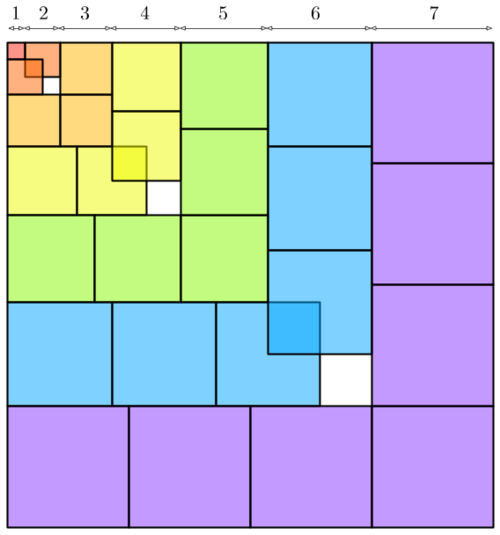Proof Without Words – Part 6
 The image above illustrates which of the following identities?
The image above illustrates which of the following identities?
This section requires Javascript.
You are seeing this because something didn't load right. We suggest you, (a) try
refreshing the page, (b) enabling javascript if it is disabled on your browser and,
finally, (c)
loading the
non-javascript version of this page
. We're sorry about the hassle.
2 solutions
I think there were 2 correct alternatives for this question, because ( 1 + 2 + 3 + . . . + n ) 2 = ( 2 n ( n + 1 ) ) 2 = 4 1 [ n ( n + 1 ) ] 2
Log in to reply
You stated a true identity, but that is not reflected in the diagram. There is no indication of why
1 + 2 + 3 + … + n = 2 n ( n + 1 ) .
Hence, the other identity is not illustrated in the image.
Log in to reply
Oh, I see. Thank you.
Yes Calvin. Thank you.
The purpose is not to state which of these equations is correct. All of them are correct. The purpose is to state which of the equations given is represented/illustrated by the diagram.
But I Solved It Easily By Looking At block (1+2) and (1+2+3) block and I Found It....
you are wrong
(1+2+3......)=( n(n+1))/2
(1^3 + 2^3 +3^3.......n^3)=(n(n+1)/2)^2
We are just waiting for part 7.
yes....both option 1 and option 4 are correct........i didnt clicked wrong
from the image we can infer that square of 1 is repeated 1 time, square of 2 is repeated 2 times and so on up to n. This gives the sum of cubes of first n integers.But the area of the complete square is the square of sum of first n integers. Equating both gives us the required answer.
You can sort of get the idea of the picture by looking at, for example, the ( 1 + 2 + 3 ) 2 square. Upon inspection (mentally making a grid of 1 × 1 squares out of the picture), you can see that the hole next to the 2 × 2 square has an area of one unit/grid-cell, which is the same area as the square made by the overlapping of the 2 × 2 squares. In fact, all of the holes/blank spots have the same area as the overlapping square to their top-left . This means that you can say the area of that ( 1 + 2 + 3 ) 2 square is ( 1 + ( 2 × 2 2 ) + ( 3 × 3 2 ) ) .
By multiplying through, you can then generalize this to 1 3 + 2 3 + … n 3 = ( 1 + 2 + … n ) 2 .